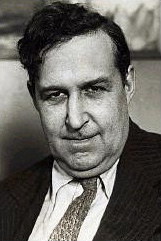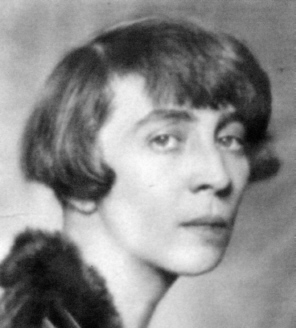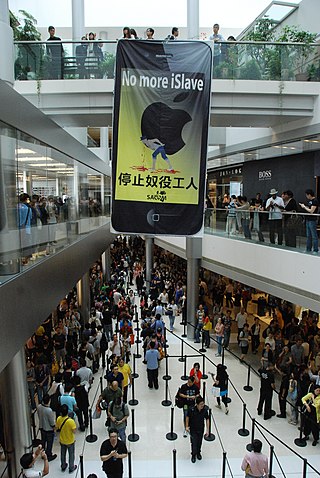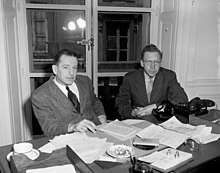
The Communications Workers of America (CWA) is the largest communications and media labor union in the United States, representing about 700,000 members in both the private and public sectors. The union has 27 locals in Canada via CWA-SCA Canada representing about 8,000 members. CWA has several affiliated subsidiary labor unions bringing total membership to over 700,000. CWA is headquartered in Washington, DC, and affiliated with the AFL–CIO, the Strategic Organizing Center, the Canadian Labour Congress, and UNI Global Union.

Heywood Campbell Broun Jr. was an American journalist. He worked as a sportswriter, newspaper columnist, and editor in New York City. He founded the American Newspaper Guild, later known as The Newspaper Guild and now as The NewsGuild-CWA. Born in Brooklyn, New York, he is best remembered for his writing on social issues and his championing of the underdog. He believed that journalists could help right wrongs, especially social ills.

Ruth Hale was an American journalist who worked for women's rights in New York City during the era before and after World War I. She was married to journalist Heywood Broun and was an associate of the Algonquin Round Table.
The International Typographical Union (ITU) was a North American trade union for the printing trade for newspapers and other media. It was founded on May 3, 1852, in the United States as the National Typographical Union, and changed its name to the International Typographical Union at its Albany, New York, convention in 1869 after it began organizing members in Canada. The ITU was one of the first unions to admit female members, admitting women members such as Augusta Lewis, Mary Moore and Eva Howard in 1869.

Wallace Turner was an American journalist and government administrator. A native of Florida, he won a Pulitzer Prize in 1957 while working for The Oregonian in Portland, Oregon. Turner later worked in the Kennedy administration before returning to the newspaper business where he worked for The New York Times.
The National Association of Broadcast Employees and Technicians (NABET-CWA) is a labor union representing employees in television, radio, film, and media production. A division of the Communications Workers of America (CWA), NABET represents about 12,000 workers organized into about 35 local unions ("locals").
Duff Wilson is an American investigative reporter, formerly with The New York Times, later with Reuters. He is the first two-time winner of the Harvard University Goldsmith Prize for Investigative Reporting, a two-time winner of the George Polk Award, and a three-time finalist for the Pulitzer Prize.

The 1936 Seattle Post-Intelligencer Strike was a labor strike that took place between August 19 and November 29, 1936. It started as the result of two senior staff members being fired after forming an alliance and joining The Newspaper Guild. The strike halted production of the newspaper for the duration of the strike. The strike ended with a formal recognition of The Newspaper Guild.
Elinor Ferry (1915–1993) was an American journalist, labor organizer, and socialist. She was member of the Independent-Socialist Party and lifelong supporter of Alger Hiss. She was married for about a decade to The Nation publisher George Kirstein.
Morris Iushewits or Iushewitz was a union activist and leader of the Newspaper Guild, the Congress of Industrial Organizations (CIO), and the American Federation of Labor and Congress of Industrial Organizations (AFL–CIO).
Jonathan Schleuss is an American journalist and the international president of the NewsGuild-CWA, a labor union representing more than 20,000 journalists and media workers in the United States and Canada. Schleuss previously worked as a graphics and data journalist at the Los Angeles Times, where in 2018 he helped lead his co-workers to organize a union with the Guild.
Jon Schleuss is an American data journalist and trade union leader who currently serves as the president of the NewsGuild-CWA. He was first elected on December 10, 2019 in a rerun election by a vote of 1,979 to 1,514. The original election, which Schleuss lost by 271 votes, was set aside by union officials in August 2019 after more than 1,000 members failed to receive ballots.

Emma Kinema is an American labor organizer and the senior campaign lead of CODE-CWA, the Communication Workers of America's Campaign to Organize Digital Employees. In the late 2010s, while working as a quality assurance tester, Kinema volunteered as a games industry organizer and co-founder of Game Workers Unite. She was hired by the CWA union in 2020 to lead their initiative to organize video game and tech workers, the first American initiative of its kind in those sectors.
A tech union is a trade union for tech workers typically employed in high tech or information and communications technology sectors. Due to the evolving nature of technology and work, different government agencies have conflicting definitions for who is a tech worker. Most definitions include computer scientists, people working in IT, telecommunications, media and video gaming. Broader definitions include all workers required for a tech company to operate, including on-site service staff, contractors, and platform economy workers.

Alphabet Workers Union (AWU), also informally referred to as the Google Union, is an American trade union of workers employed at Alphabet Inc., Google's parent company, with a membership of over 800, in a company with 130,000 employees, not including temps, contractors, and vendors in the United States. It was announced on January 4, 2021 with an initial membership of over 400, after over a year of secret organizing, and the union includes all types of workers at Alphabet, including full-time, temporary, vendors and contractors of all job types.

The Campaign to Organize Digital Employees or CODE-CWA is a project launched by the Communications Workers of America to unionize tech and video game workers in January 2020. It sprung out of conversations with Game Workers Unite (GWU) and employed at least two full time staff, including GWU co-founder Emma Kinema and veteran SEIU organizer Wes McEnany. In 2022, Jessica Gonzalez joined, a former Activision Blizzard QA tester.

Apple Inc. workers around the globe have been involved in organizing since the 1990s. Apple worker organizations have been made up of retail, corporate, and outsourced workers. Employees have joined trade unions and formed works councils in Australia, France, Germany, Italy, Japan, United Kingdom and the United States.
Kenneth G. Crawford (1902–1983), was an American newspaper and magazine journalist for PM and Newsweek and during a "distinguished career" was a confidant of US presidents from Franklin Delano Roosevelt to Richard M. Nixon.
Molière is a 1919 play written by Philip Moeller, who subtitled it "A Romantic Play in Three Acts". It has a medium-sized cast, moderate pacing, and two sets; Acts I and III share the same set. Some of the play's characters are historical, figures from the French court of the 1670s. The first two acts have a single scene, while the third has a curtain drop to signal the passage of two hours time. The play shows a few scenes from the twilight of Molière, as he loses the favor of Louis XIV but retains his independence.










